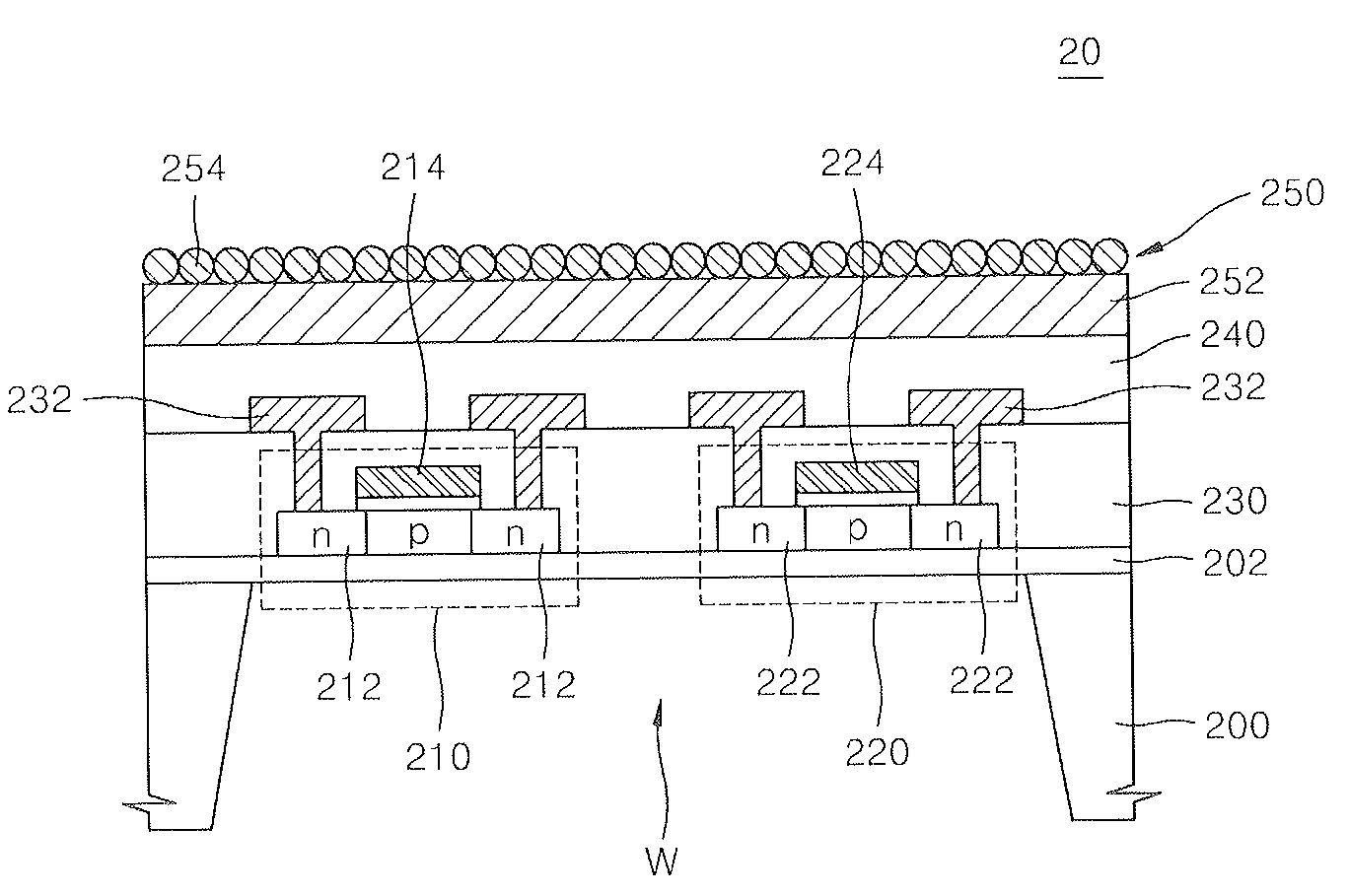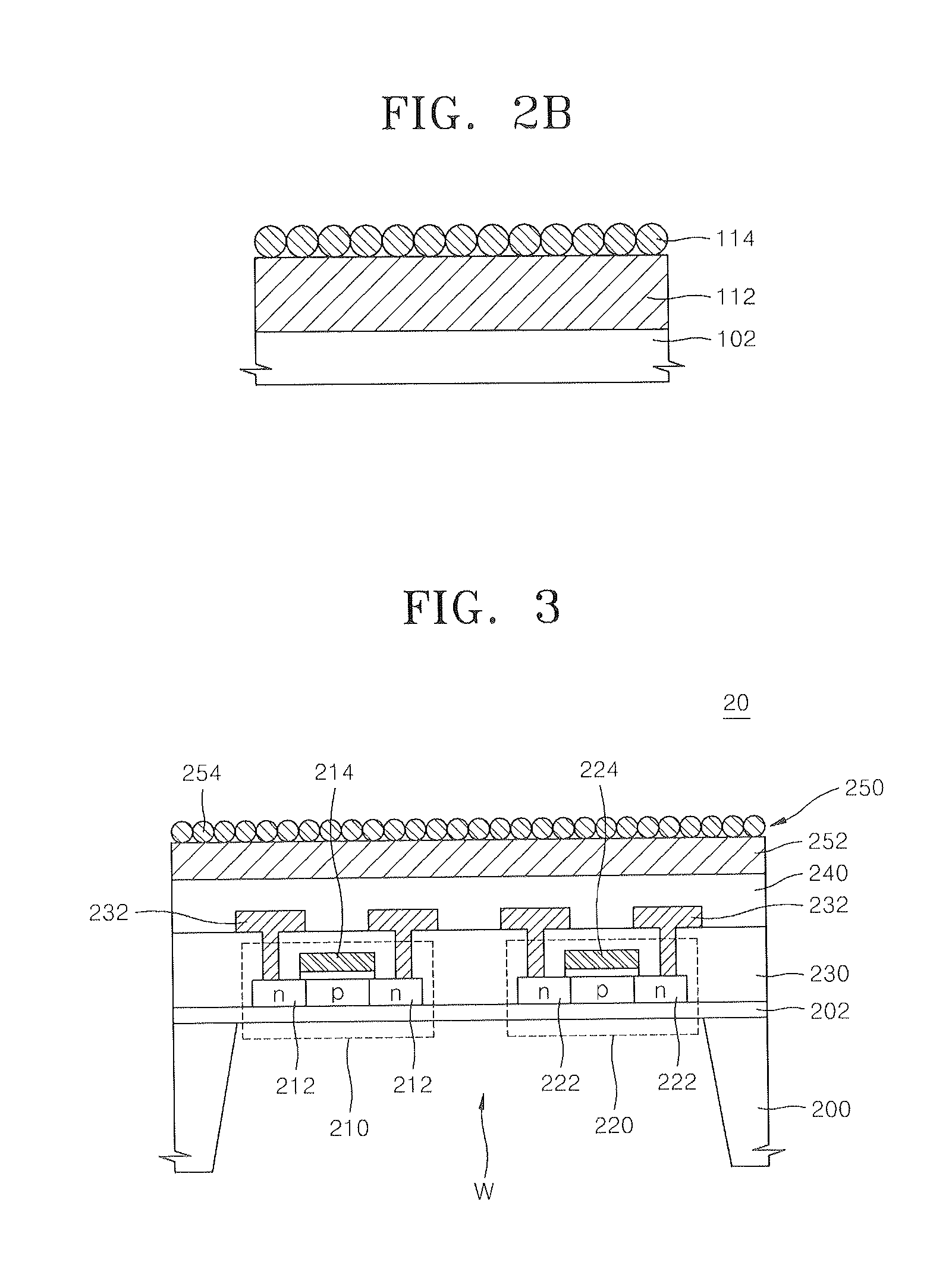Method of forming sensor for detecting gases and biochemical materials, integrated circuit having the sensor, and method of manufacturing the integrated circuit
a biochemical material and sensor technology, applied in the field of forming sensors, can solve the problems of difficult integration of sensors and unit elements, difficult miniaturization process, etc., and achieve the effect of preventing the degradation of the integrated circuit caused by heating the unit devices when forming the sensors
- Summary
- Abstract
- Description
- Claims
- Application Information
AI Technical Summary
Benefits of technology
Problems solved by technology
Method used
Image
Examples
example 1
[0058]In order to make a metal oxide nano structure layer grow using sputtering facility, an electrode formed of a polycrystalline metal film having a thickness of about 1000 nm was formed on an upper surface of a silicon substrate in a plane orientation (100). Thereafter, the silicon substrate formed with the electrode was loaded in a reaction chamber having a ZnO target, and ZnO was grown by using RF sputtering. A pressure within the reaction chamber was controlled to roughly 3.8×10−3 Pa or less, before growing the ZnO nano structure, i.e., before loading the silicon substrate within the reaction chamber. When the ZnO nano structure was being grown within the reaction chamber, a pressure of about 2.3 Pa was maintained within the reaction chamber and an RF power of about 150 watt is applied. While the ZnO nano structure was being grown within the reaction chamber, a temperature within the reaction chamber was maintained at room temperature.
example 2
[0059]In order to observe the change of the nano structure form resulting from a quantity of oxygen in an ambient environment within the reaction chamber when making the metal oxide nano structure layer grow according to the method of the Example 1, ZnO nano structure was grown under a condition that O2 and Ar have a flow rate ratio (O2 / Ar) of 0, 0.2 and 0.4, respectively.
[0060]For this operation, after a Ti thin film was formed on a p-type (100) silicon substrate, a Cu film was formed thereon for about 5 minutes by electro-plating. Thereafter, ZnO was grown on a surface of the Cu film for 15 minutes within the sputtering reaction chamber maintaining the temperature and pressure of the ambient environment as described in Example 1.
[0061]FIG. 4 shows SEM images displaying results of growing the ZnO nano structure each obtained according to a flow rate ratio of O2 / Ar as a result of Example 2.
[0062]FIG. 5 illustrates results of analyzing X-ray diffraction peaks with respect to the resu...
example 3
[0069]In order to observe the change of the nano structure form associated with a growth within the reaction chamber when making the metal oxide nano structure layer grow by the method according to Example 1, two growth cases for 15 minutes and 50 minutes of the ZnO nano structure were compared under the state where the flow rate ratio (O2 / Ar) of O2 and Ar maintains 0.2 within the reaction chamber.
[0070]For this operation, samples having electrodes by sequentially forming Ti and Cu thin films on a p-type (100) silicon substrate were prepared by the method according to Example 2. Then, the samples were classified into two groups, and ZnO is grown for 15 minutes and 50 minutes on the electrodes with respect to the two groups in a sputtering reaction chamber wherein the temperature and the pressure were maintained in the ambient environment as described in Example 1.
[0071]FIG. 7 shows SEM images each displaying resultant structures where the ZnO nano structures are grown as the result ...
PUM
 Login to View More
Login to View More Abstract
Description
Claims
Application Information
 Login to View More
Login to View More - R&D
- Intellectual Property
- Life Sciences
- Materials
- Tech Scout
- Unparalleled Data Quality
- Higher Quality Content
- 60% Fewer Hallucinations
Browse by: Latest US Patents, China's latest patents, Technical Efficacy Thesaurus, Application Domain, Technology Topic, Popular Technical Reports.
© 2025 PatSnap. All rights reserved.Legal|Privacy policy|Modern Slavery Act Transparency Statement|Sitemap|About US| Contact US: help@patsnap.com



